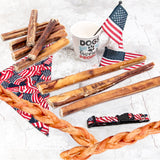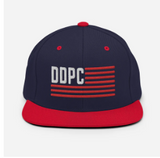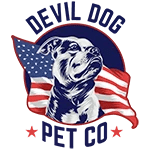The Power of Peanut: 7 Foods That Transform Your Dog's Health
When our dog Dexter first turned his nose up at his kibble, I knew we had a problem. As a Marine, I was trained to adapt and overcome—not give in to a canine hunger strike. But after two days of standoffs, I caved and smeared a dab of peanut butter on his food bowl rim. That tablespoon of nutty goodness didn't just get him eating again; it became our secret weapon for everything from medication to bath time.
Let's cut through the fluff: peanut products aren't just bribes. They're legitimate nutritional powerhouses when used correctly. The right peanut-based foods can boost your dog's health, strengthen your training program, and create moments of pure joy—without compromising their wellbeing.
But here's the hard truth many blogs won't tell you: not all peanut products deserve a place in your dog's diet. Some contain additives that can literally kill your four-legged family member. As responsible leaders, we need to separate fact from marketing hype.
The Science Behind Peanut Benefits for Dogs
Before we dive into specific foods, let's establish why quality peanut products earn their place in a balanced canine diet. Peanuts deliver protein (about 7g per ounce), healthy fats, vitamin E, niacin, and manganese. These nutrients support muscle maintenance, skin health, and metabolic function.
The protein in peanuts contains all essential amino acids your dog needs, though in different proportions than meat sources. That's why peanut products work best as supplements to high-quality animal proteins, not replacements.
The fat profile is where peanuts truly shine. They're rich in monounsaturated fats—the same heart-healthy fats found in olive oil. For active dogs, these fats provide sustained energy without the blood sugar spikes that can trigger hyperactivity.
The Safety Factor: What Makes a Peanut Product Dog-Friendly
Not all peanut butter is created equal. The difference between safe and dangerous comes down to one ingredient: xylitol. This artificial sweetener is perfectly fine for humans but triggers a massive insulin release in dogs, potentially causing fatal hypoglycemia within 30-60 minutes of consumption.
Check every label, every time. Safe peanut butter contains peanuts and maybe salt—that's it. Brands adding sugar, hydrogenated oils, or preservatives aren't ideal, but xylitol is the absolute dealbreaker.
Top 7 Peanut-Based Foods to Elevate Your Dog's Diet

1. Plain Natural Peanut Butter
The gold standard for peanut dog treats starts with single-ingredient peanut butter. Brands like Adams and Crazy Richard's offer nothing but ground peanuts—no salt, sugar, or oils added. This pure form delivers maximum nutrition with minimum risk.
Serving suggestion: Freeze tablespoon-sized portions in silicone ice cube trays. These "peanut pucks" make perfect rewards for major training breakthroughs or distractions during grooming sessions. The frozen texture extends enjoyment time and soothes gums in teething puppies.
2. Peanut Butter-Enhanced Yak Chews
When standard yak butter dog chews aren't exciting enough for picky eaters, a thin peanut butter coating can transform their appeal. The combination of hard Himalayan cheese with a hint of peanut creates an irresistible flavor profile while maintaining the dental benefits of long-lasting chews.
Our Himalayan Yak Cheese Chews become even more enticing with a light peanut butter application. The protein-packed cheese base provides hours of focused chewing, while the peanut flavor adds that extra motivation factor that keeps dogs engaged.
Explore our Yak Cheese Himalayan Dog Chews collection to find these irresistible treats for your dog.
3. Homemade Peanut Training Bites
Commercial peanut butter dog chews often contain unnecessary fillers. Instead, try this three-ingredient alternative that maintains perfect texture for training:
- 1 cup natural peanut butter
- 2 cups oat flour (regular oats pulsed in a blender)
- 1 tablespoon honey (optional for binding)
Mix ingredients, roll into pea-sized balls, and refrigerate. These tiny rewards deliver big flavor without crumbling in your treat pouch during long training sessions. The small size allows for rapid consumption without breaking focus—crucial for maintaining momentum during complex command sequences.
For more information on food allergies in dogs, visit VCA Hospitals: Food Allergies in Dogs.
4. Peanut-Stuffed Antler Ends
When your dog has worked through most of an antler chew, the remaining nub becomes the perfect vessel for a peanut surprise. The marrow cavity in split antler ends holds just enough peanut butter to renew interest in a familiar chew.
This combination delivers the dental benefits and long-lasting nature of antlers with the flavor appeal of peanut butter. It's particularly effective for dogs who tend to lose interest in chews before they're fully utilized.
Check out our Split Antler Dog Chews collection to find the perfect antlers for stuffing peanut butter and delighting your dog.
5. Frozen Peanut & Pumpkin Cubes
This powerhouse combination supports digestive health while satisfying the peanut butter craving:
- 1 cup plain canned pumpkin (not pie filling)
- ½ cup natural peanut butter
- ¼ cup plain Greek yogurt
Blend ingredients and freeze in silicone molds. The fiber from pumpkin supports healthy digestion, while probiotics in yogurt promote gut health. The peanut butter ensures enthusiastic consumption of these functional treats.
Learn more about the best food for dogs with allergies at Denver Vet: Best Food for Dogs with Allergies.
6. Peanut-Infused Bone Broth
For dogs needing extra hydration or recovering from illness, peanut-enhanced bone broth provides nutrition in an easily digestible form:
- 4 cups homemade or store-bought unseasoned bone broth
- 2 tablespoons natural peanut butter
- 1 tablespoon unflavored gelatin (optional for joint support)
Warm broth slightly, whisk in peanut butter until fully incorporated, then add gelatin if using. Serve room temperature as a meal topper or freeze in ice cube trays for refreshing summer treats.
7. Peanut Butter-Filled Bully Sticks
For the ultimate high-value reward, our premium bully sticks can be enhanced with a small amount of peanut butter. The protein-rich, single-ingredient chew provides extended entertainment, while the peanut butter adds irresistible flavor.
This combination works particularly well for crate training or during thunderstorms when you need maximum distraction power. The act of working to extract the peanut butter creates mental stimulation beyond what either component offers alone.
Discover our Ultra Thick Bully Sticks collection to give your dog this premium peanut butter-enhanced experience.
When Peanut Products Aren't Appropriate

Despite their benefits, peanut dog treats aren't right for every situation. Skip them if:
- Your dog has shown any signs of peanut sensitivity (itching, digestive upset)
- You're working on weight management (peanut products are calorie-dense)
- You're dealing with pancreatitis or other fat-restricted conditions
- Your veterinarian has advised against them
Remember: treats of any kind should constitute no more than 10% of your dog's daily caloric intake. Even healthy additions can unbalance a carefully planned diet when overused.
Strategic Uses for Peanut Butter Chews
As a Marine, I learned that proper application of resources wins battles. The same principle applies to peanut butter dog chews. Use them strategically for maximum impact:
Distraction During Medical Procedures
When our dog Dexter needed his ears cleaned weekly, we discovered that a lick mat smeared with frozen peanut butter kept him still for the entire process. The combination of cold temperature and rich flavor created enough focus to override his discomfort.
For nail trims, heartworm pills, or other brief procedures, a peanut butter chew toy can transform a wrestling match into a cooperative session. The key is preparation—have the peanut butter ready before starting the procedure.
Crate Training Breakthrough Tool
Peanut butter dog chews excel at building positive crate associations. A frozen Kong stuffed with peanut butter provides 20-30 minutes of focused engagement—perfect for the critical first phase of crate training when you're building tolerance.
Unlike treats that disappear quickly, a well-designed peanut butter chew creates sustained enjoyment that helps dogs associate confinement with pleasure rather than punishment. This technique has saved countless pieces of furniture during the transition from crate to house freedom.
Anxiety Management
For dogs with noise phobias or separation anxiety, peanut butter chews create a powerful distraction through taste, smell, and repetitive licking motion. The physical act of licking releases endorphins that counteract stress hormones—a biological hack that transforms panic into focus.
A customer's German Shepherd went from destroying door frames during thunderstorms to calmly working on a peanut butter-filled antler through even the loudest storms. The combination of physical engagement and flavor focus redirected his fear response.
Peanut Butter Application Techniques

How you deliver peanut butter matters as much as which product you choose. These application methods maximize benefits while minimizing mess:
The Freeze-First Method
For any hollow chew or toy, freezing peanut butter inside extends engagement time dramatically. Fill the cavity, seal any openings with a dab of peanut butter "cement," and freeze for at least four hours. The frozen core forces slow, deliberate licking rather than gulping.
This technique works brilliantly with our split antler chews. The marrow cavity holds just enough peanut butter to create interest without excessive calories.
The Thin-Layer Approach
When using peanut butter as medication camouflage, less is more. A paper-thin layer creates enough flavor appeal without allowing pills to slide around or be licked off. Spread with the back of a spoon rather than a knife for precision control.
For peanut butter dog chews like bully sticks, a barely-there coating adds flavor without creating a sticky mess. Warm the peanut butter slightly for easier spreading, then refrigerate the coated chew to set the layer.
The Stuffed-Center Technique
For hollow natural chews, create a surprise center by filling with peanut butter, then sealing the opening with a small piece of carrot or apple. This technique transforms a familiar chew into an exciting puzzle that engages problem-solving skills.
When our dog Dexter mastered basic chews too quickly, this method added a new dimension that kept his interest through multiple sessions. The cognitive challenge proved as rewarding as the flavor itself.
Peanut Butter Application Techniques for Maximum Benefit
The right peanut dog delivery system makes all the difference between a fleeting treat and a transformative training tool. After testing dozens of methods with our dog Dexter, we've refined these techniques to military-grade precision.
The Layering Strategy for Yak Chews
Himalayan yak butter dog chews already offer impressive staying power, but strategic peanut application takes them to another level. Rather than coating the entire chew, create targeted "flavor zones" by applying thin layers to alternating sections. This technique produces intermittent reward patterns—the same psychological principle that makes slot machines addictive to humans.
When your dog hits a peanut butter pocket after working through a plain section, the unexpected flavor burst renews motivation. We've seen this method double engagement time with even the most easily distracted dogs.
Peanut Butter Chew Rotation Protocol
Even the best peanut butter dog chews lose their appeal through overexposure. Implement a strict rotation schedule—three days on, four days off—to maintain the "high-value" status of peanut-enhanced items. During off days, offer alternative flavors or textures to prevent palate fatigue.
This disciplined approach preserves the power of peanut butter for when you truly need it, like veterinary visits or thunderstorm events. Dogs with constant access to peanut products quickly become desensitized to their appeal.
Troubleshooting Common Peanut Dog Issues

Even the most carefully planned peanut butter dog chew strategy can hit snags. Here's how to overcome typical challenges:
The Gulper Problem
Some dogs attempt to swallow peanut butter treats whole rather than savoring them. This dangerous habit defeats both the dental benefits and the engagement purpose. For these "inhaler" types, try freezing peanut butter in silicone molds with a vertical opening too narrow for their jaw span. The physical limitation forces methodical licking instead of gulping.
A customer's Labrador went from swallowing peanut butter treats in seconds to spending 20+ minutes working through the same amount when presented in this format. The mental stimulation improved dramatically while eliminating safety concerns.
The Mess Factor
Peanut butter's sticky nature can create household chaos. Contain the situation by designating specific "peanut zones" in your home—areas with washable flooring and minimal fabric. Train your dog to take peanut butter chews only to these approved locations.
For portable options, our split antler chews with minimal peanut butter application create almost no residue. The hard surface provides a clean-grip handle while the dog works on the peanut-enhanced end.
Calorie Control for Peanut Dog Treats
At 90-100 calories per tablespoon, peanut butter can quickly derail weight management efforts. Create the illusion of abundance by whipping air into peanut butter—blend with an electric mixer for 2-3 minutes until volume doubles. The increased surface area enhances aroma and flavor perception while cutting caloric density.
This technique works particularly well for stuffing toys or spreading on lick mats. Your dog perceives the same reward value from half the calories—a win-win for both health and behavior management.
Building the Ultimate Peanut Dog Training System
Serious trainers know that different rewards serve different purposes. Construct a tiered peanut reward hierarchy to maximize training effectiveness:
Tier 1: Micro-Rewards (Everyday Training)
For frequent reinforcement during basic skill building, use pea-sized peanut butter dog chews that deliver flavor without interrupting flow. These tiny rewards acknowledge correct responses without derailing focus. The homemade peanut training bites mentioned earlier work perfectly here.
A three-minute training session might include 15-20 of these micro-rewards, so portion control is crucial. Each bite should provide just enough taste to register as positive without creating fullness or distraction.
Tier 2: Milestone Rewards (Session Completers)
When your dog masters a challenging sequence or completes a difficult training set, upgrade to a more substantial peanut butter dog chew. A small bully stick with light peanut butter enhancement or a peanut-stuffed split antler end provides the perfect "you crushed it" acknowledgment.
These intermediate rewards signal the end of a successful work period and build positive associations with challenging tasks. The combination of chewing satisfaction and flavor creates a multi-sensory reward experience.
Tier 3: Breakthrough Celebrations (Major Achievements)
Reserve your most elaborate peanut dog creations for genuine breakthrough moments—the first perfect recall from distraction, conquering a long-standing fear, or mastering a complex service task. These rare rewards should create memorable experiences that cement the importance of the achievement.
A frozen Kong stuffed with layers of peanut butter, plain yogurt, and small training treats creates a 30-minute celebration activity that marks the occasion as truly special. The time investment in preparing these rewards matches their significance in your training progression.
The Science Behind Peanut Butter's Training Power
The effectiveness of peanut dog treats isn't just anecdotal—it's backed by solid behavioral science. The combination of fat and protein triggers multiple reward pathways in the canine brain:
First, the rich fat content activates pleasure centers similar to those stimulated by meat. Second, the protein satisfies deeper nutritional drives. Third, the distinctive aroma creates powerful associative memories that strengthen training connections. This triple-threat makes peanut butter uniquely effective compared to single-note rewards.
Research shows that varied reinforcement schedules maintain behavior better than consistent patterns. By strategically deploying different peanut butter delivery methods—sometimes as direct treats, sometimes in puzzle toys, sometimes as chew enhancements—you create the variable reward pattern that builds rock-solid reliability.
Conclusion: Leading with Purpose in Peanut Dog Nutrition
Effective dog leadership isn't about domination—it's about making informed choices that balance enjoyment with health. Peanut butter dog chews represent this balance perfectly: they deliver genuine pleasure while serving training, dental, and enrichment purposes.
The key is intentionality. Random treat-giving creates entitlement; strategic reward systems build partnership. When you thoughtfully incorporate peanut butter chews into a comprehensive training and enrichment plan, you're not just indulging your dog—you're building communication pathways that strengthen your bond.
At Devil Dog Pet Co., we believe that every interaction with your dog should serve a purpose. Whether you're using our premium bully sticks with a hint of peanut butter as a crate training tool or combining our split antlers with strategic peanut filling for extended engagement, you're practicing Extreme Dog Leadership—taking full responsibility for your dog's behavioral development.
Remember: the best peanut dog strategy is one that fits your specific training goals, your dog's individual preferences, and your household routines. There's no one-size-fits-all approach, but the principles of quality ingredients, appropriate portioning, and purposeful application remain universal.
Lead with confidence, train with purpose, and enjoy the journey—one perfectly planned peanut butter chew at a time.
For additional ways to improve your dog's daily wellbeing, consider reading our guide on managing your pup's shedding and explore our recommendations for dog diapers if you're dealing with house training or incontinence. When preparing for busy holidays, check out our article on keeping your dog calm during Halloween, and for those who love adventure, our comprehensive guide to traveling with dogs is a must-read.
Looking to expand your canine care knowledge? Don't miss our post on basic first aid skills every pup parent should know. For healthy snacking, review our resource on single-ingredient dog treats. If you're planning ahead, set your intentions with New Year goals for your pup. And if chews are your focus, learn more about choosing safe dog chews that fit your dog's size and needs.
For more insights on managing food allergies in dogs, check out Michigan Animal Hospital: Food for Dogs with Allergies.
Download the FREE 10-Step Dog Prep Guide
Frequently Asked Questions
What is a peanut dog?
A peanut dog is a playful term often used to describe small, adorable dogs that are as cute and compact as a peanut. It can also refer to dogs that have a unique peanut-shaped marking or an affectionate nickname given by their owners. This term is more of an endearing nickname rather than a specific breed or official category.
Are peanuts ok for a dog to eat?
Plain, unsalted peanuts in moderation are generally safe for dogs to eat and can even provide some protein and healthy fats. However, peanuts should be given sparingly because they are high in fat and can cause digestive upset or obesity if overconsumed. It's important to avoid peanuts with added salt, sugar, or flavorings, and never feed dogs peanut products containing xylitol, which is toxic to them.
What is the story of peanut the dog?
Peanut the dog is a beloved pet known for their charming personality and unique appearance, often shared in viral social media posts or heartwarming stories. Many Peanut dogs have captured hearts due to their resilience, funny antics, or special bonds with their owners. These stories celebrate the joy and companionship that Peanut dogs bring into people's lives.
What happened to peanut Angelina's dog?
Peanut, Angelina's dog, became well-known after a touching story about their bond surfaced, highlighting the deep connection between pet and owner. Specific details about Peanut's life or fate vary depending on the source, but generally, such stories emphasize love, care, and sometimes challenges faced together. If you’re referring to a particular incident, more context would help clarify what happened.
What breed of dog is Peanuts?
The name Peanuts is often used affectionately for dogs of various breeds, so without additional context, it is hard to specify one breed. In many popular references, Peanuts may be small breeds like Chihuahuas, Dachshunds, or mixed breeds known for their cuteness and small size. The breed can vary widely depending on the individual dog named Peanuts.
What is Nutting a dog?
Nutting a dog typically refers to the act of neutering or spaying a dog, which is a surgical procedure to sterilize the animal and prevent reproduction. This is a common practice to control pet populations and can also offer health and behavioral benefits for dogs. The term 'nutting' is a casual or slang way some people refer to this important veterinary procedure.






